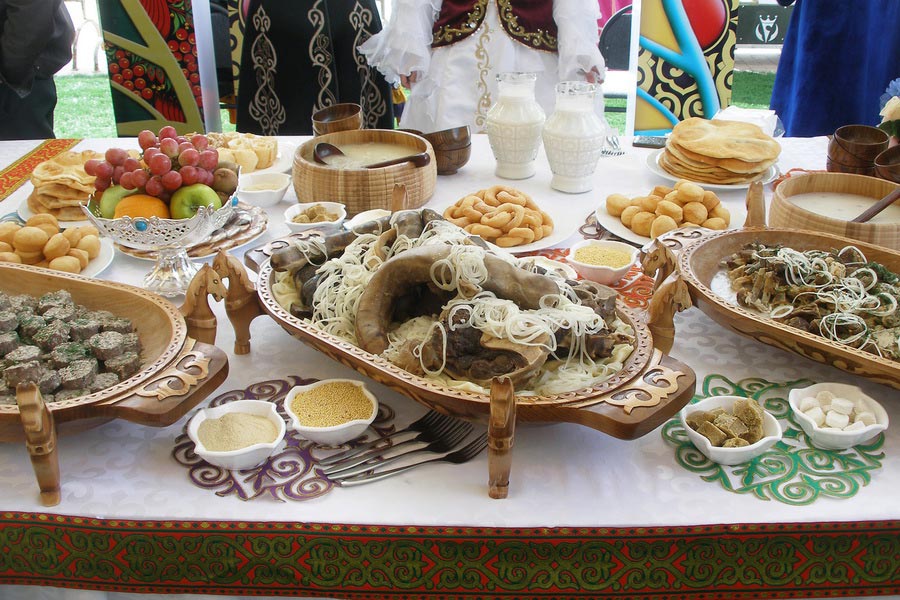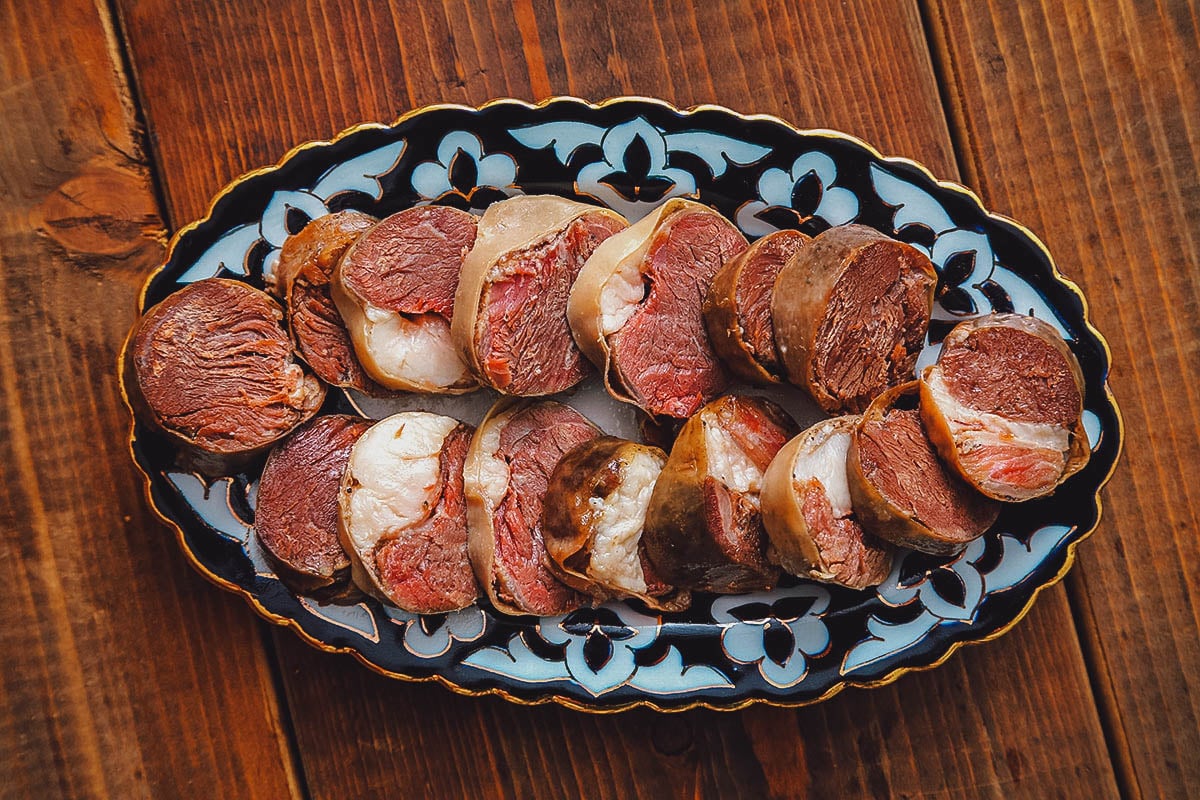Kazakh meals, a vibrant tapestry of flavors and traditions, invitations us on a culinary journey that spans centuries and areas. From the nomadic roots of beshbarmak to the fashionable fusion dishes that mix heritage with innovation, Kazakh delicacies captivates with its wealthy historical past, numerous elements, and fascinating flavors.
All through this culinary exploration, we are going to delve into the origins and influences which have formed Kazakh delicacies, uncover the normal elements and dishes that outline its character, and discover the regional variations that replicate the nation’s numerous panorama. We may even witness the evolution of Kazakh meals in current instances, because it embraces fashionable developments and beneficial properties worldwide recognition.
Culinary Historical past of Kazakh Delicacies

The origins of Kazakh delicacies lie within the nomadic traditions of the Kazakh individuals, who roamed the huge steppes of Central Asia for hundreds of years. Their delicacies is characterised by easy, hearty dishes that may be simply ready over an open fireplace or in a cauldron.
One of many key influences on Kazakh delicacies is the area’s local weather. The cruel winters and scorching summers of the steppe have led to a reliance on preserved and dried meals, corresponding to kurt (dried fermented milk) and kazy (horse meat sausage).
Timeline of Key Culinary Occasions in Kazakh Historical past
- thirteenth century:The Mongol invasion of Central Asia brings new elements and cooking methods to the area.
- sixteenth century:The Kazakhs grow to be a definite ethnic group and develop their very own distinctive culinary traditions.
- nineteenth century:Russian colonization introduces new crops and elements to Kazakhstan, corresponding to potatoes and tomatoes.
- twentieth century:The Soviet Union collectivizes agriculture in Kazakhstan, resulting in a decline in conventional nomadic practices and a shift in the direction of extra settled agriculture.
- Submit-independence:Kazakhstan regains its independence in 1991 and begins to revive its conventional culinary traditions.
Function of Nomadic Traditions in Shaping Kazakh Meals Tradition
The nomadic way of life of the Kazakhs has had a profound influence on their meals tradition. The necessity to journey mild and be capable of put together meals shortly and simply led to the event of straightforward, transportable dishes. The reliance on livestock for sustenance additionally meant that meat, dairy, and different animal merchandise play a central position in Kazakh delicacies.
Nomadic traditions additionally influenced the way in which that Kazakhs protect and retailer meals. The cruel local weather of the steppe meant that meals had to have the ability to face up to lengthy intervals of storage. This led to the event of methods corresponding to drying, smoking, and fermenting.
Conventional Elements and Dishes
Kazakh delicacies is a mirrored image of the nation’s nomadic heritage, characterised by hearty and flavorful dishes made with recent, domestically sourced elements. These elements kind the muse of conventional Kazakh meals, offering a novel and genuine culinary expertise.
Here’s a desk showcasing among the key elements and dishes in Kazakh delicacies, together with their descriptions and utilization:
| Ingredient/Dish | Description | Utilization in Kazakh delicacies | Picture |
|---|---|---|---|
| Beshbarmak | A standard Kazakh dish consisting of boiled horse or lamb meat served with noodles and a broth | A staple dish served on particular events and celebrations | [Image of Beshbarmak] |
| Kazy | A sort of horse meat sausage seasoned with spices and garlic | Used as a major ingredient in Beshbarmak and different dishes | [Image of Kazy] |
| Kumys | A fermented mare’s milk beverage | A standard drink consumed for its dietary and medicinal properties | [Image of Kumys] |
| Baursak | A deep-fried dough ball just like a donut | Served as a facet dish or dessert, typically accompanied by honey or jam | [Image of Baursak] |
Regional Variations in Kazakh Delicacies

Kazakhstan’s huge territory and numerous landscapes contribute to regional variations in its delicacies. Local weather, geography, and cultural influences form distinct culinary types throughout the nation.
Northern Kazakhstan
- Influenced by Russian and Siberian cuisines, that includes hearty soups, dumplings, and pastries.
- Examples: Beshbarmak(horse meat and noodles), Pelmeni(dumplings).
Central Kazakhstan
- Central location permits for a mix of influences from varied areas.
- Recognized for its grilled meats, rice dishes, and dairy merchandise.
- Examples: Kuyrdak(grilled lamb), Pilaf(rice dish with meat and greens), Kumys(fermented mare’s milk).
Southern Kazakhstan
- Influenced by Central Asian cuisines, with a give attention to rice, lamb, and greens.
- Options dishes with a mix of candy and savory flavors.
- Examples: Plov(rice dish with lamb and greens), Samsa(pastries stuffed with meat or greens).
Western Kazakhstan
- Shares similarities with Russian and Ukrainian cuisines.
- Options soups, stews, and fish dishes.
- Examples: Borscht(beetroot soup), Ukrop(dill soup), Ryba po-Kazakhski(Kazakh-style fish).
Japanese Kazakhstan
- Influenced by Chinese language and Mongolian cuisines.
- Recognized for its noodles, dumplings, and dairy merchandise.
- Examples: Laghman(noodle soup), Manty(steamed dumplings), Ayran(fermented milk drink).
Kazakh Meals Festivals and Celebrations
Meals holds immense significance in Kazakh tradition, and festivals and celebrations aren’t any exception. These occasions present a possibility for households and communities to collect, share scrumptious meals, and have fun their heritage.
Conventional Dishes throughout Celebrations
Throughout Kazakh festivals, conventional dishes are ready and consumed, every with its personal symbolic which means. Beshbarmak, a dish made with boiled horse meat, noodles, and broth, is a staple at many celebrations, representing hospitality and abundance. Different in style dishes embody plov (rice pilaf), kuirdak (lamb stew), and baursak (fried dough balls).
Fashionable Developments in Kazakh Delicacies
Kazakh delicacies, steeped in custom, has undergone a dynamic evolution in current instances. Up to date culinary developments are leaving an indelible mark on conventional dishes, giving rise to modern and thrilling creations that mix the outdated with the brand new.
Rising Culinary Developments, Kazakh meals
- Fusion Delicacies:Kazakh cooks are experimenting with world flavors, incorporating components from varied cuisines into conventional dishes. This cross-cultural change has resulted in distinctive and flavorful creations.
- Molecular Gastronomy:Methods corresponding to sous vide and spherification are being employed to boost the textures and flavors of conventional elements. This scientific strategy to cooking provides a component of innovation and class.
- Sustainability:There’s a rising emphasis on utilizing native and seasonal elements, decreasing waste, and selling environmentally pleasant practices in Kazakh delicacies.
Revolutionary Dishes
These developments are evident within the emergence of modern dishes that push the boundaries of conventional Kazakh delicacies:
- Beshbarmak with Truffle Foam:A traditional Kazakh dish of boiled horse meat and noodles is elevated with an expensive truffle foam, including an earthy and umami taste.
- Kyimak Sorpa with Saffron and Pistachios:This conventional soup made with fermented dairy merchandise is infused with fragrant saffron and crunchy pistachios, making a harmonious mix of flavors and textures.
- Kazy with Molecular Glaze:Cured horse sausage, a staple in Kazakh delicacies, is remodeled with a molecular glaze that enhances its sweetness and provides a shiny end.
These modern dishes exemplify the dynamic evolution of Kazakh delicacies, the place custom meets modernity to create thrilling and memorable culinary experiences.
Kazakh Delicacies within the World Context

Kazakh delicacies is gaining recognition worldwide attributable to its distinctive flavors, use of recent elements, and nomadic heritage. Eating places, cookbooks, and social media play a major position in selling Kazakh meals tradition internationally.
Worldwide Recognition
Kazakh cooks and meals lovers have launched the world to the delights of Kazakh delicacies. For instance, chef Mukhtar Mukhitdinovich has showcased Kazakh dishes at worldwide culinary occasions, incomes accolades for his or her authenticity and creativity.
Cookbooks and Social Media
Cookbooks like “The Kazakh Cookbook” by Nurzada Sadykova present detailed recipes and insights into Kazakh culinary traditions. Social media platforms corresponding to Instagram and YouTube characteristic meals bloggers and cooks sharing their experiences with Kazakh delicacies, inspiring a world viewers.
Questions Typically Requested
What’s the nationwide dish of Kazakhstan?
Beshbarmak, a dish of boiled horse or lamb meat served with noodles and broth, is taken into account the nationwide dish of Kazakhstan.
What’s the hottest drink in Kazakhstan?
Kumys, a fermented mare’s milk, is a conventional and in style beverage in Kazakhstan.
Is Kazakh meals spicy?
Whereas some Kazakh dishes incorporate spices, the delicacies is mostly not thought-about spicy.

